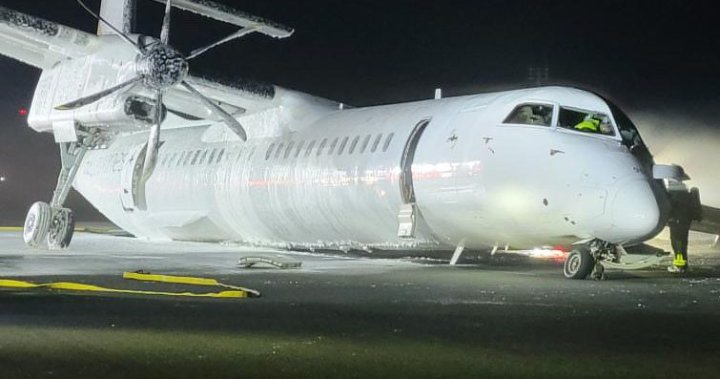On December 28, 2024, Air Canada Express Flight, operated by PAL Airlines, experienced a harrowing landing at Halifax Stanfield International Airport. Carrying 73 passengers and four crew members, the De Havilland Dash 8 turboprop aircraft suffered a blown tire during takeoff from St. John’s International Airport. This seemingly minor incident escalated dramatically upon landing in Halifax, culminating in a collapsed landing gear, a fiery engine, and a chaotic evacuation that left passengers stranded in the cold for an extended period. The incident has not only sparked concerns about the mechanical failure itself but also raised serious questions about the adequacy of the airport’s emergency response protocols.
Passenger Steve Mahar recounted the frightening experience, describing not only the rough landing and subsequent engine fire but also the disarray that followed. Passengers were forced to jump approximately four and a half feet from the aircraft due to the lack of an emergency platform. Following the evacuation, they were left standing on the tarmac in the frigid December night for an hour with inadequate assistance. Mahar expressed particular concern for the vulnerable passengers, including seniors and children, who were exposed to the cold with no immediate provision of blankets or shelter. He criticized the airport’s apparent lack of preparedness and the slow response in providing relief to the stranded passengers. This account paints a picture of a disorganized and inadequate emergency response, raising serious questions about the airport’s preparedness for such incidents.
The Transportation Safety Board of Canada (TSB) conducted a preliminary investigation and released a brief report attributing the incident to the blown tire in St. John’s. The report detailed how the damaged tire caused vibrations upon landing in Halifax, ultimately leading to the landing gear collapse and the subsequent engine fire. While the TSB’s report identified the mechanical root cause of the incident, it did not address the concerns regarding the airport’s emergency response. This has led to calls for a broader investigation into the airport’s emergency preparedness protocols.
Advocates for Safer Airports in Canada, an advocacy group focused on airport safety, has called for a more thorough investigation, specifically examining the emergency response plan implemented by Halifax Stanfield International Airport. The group argues that the current regulatory framework for airport emergency preparedness in Canada is insufficient and puts passengers at risk. Chris Bussey, the chair of the advocacy group, emphasized the lack of independent oversight of airport emergency planning and highlighted the limited standards airports are required to meet. He compared these standards unfavorably to international regulations, suggesting that the Canadian system falls short in ensuring passenger safety during emergencies. This call for further investigation underscores the need for greater scrutiny of airport emergency plans across the country.
Bussey’s critique points to a systemic issue within the Canadian aviation regulatory environment. He argues that the current system relies heavily on self-auditing by airport authorities, lacking an independent body to rigorously evaluate the effectiveness of emergency plans. This lack of external oversight raises concerns about the objectivity and thoroughness of these evaluations, potentially leaving gaps in preparedness and compromising passenger safety. The absence of standardized and enforced emergency protocols across Canadian airports, compared to international best practices, suggests a vulnerability that needs urgent address.
The incident and its aftermath have prompted legal action. Wagners, a Halifax law firm, has reported being contacted by multiple passengers involved in the incident. The firm is currently evaluating the possibility of launching a class-action lawsuit against the involved parties. This potential legal action signifies the seriousness of the situation and the passengers’ intent to seek redress for the distress and inconvenience they experienced. It also underscores the importance of a comprehensive investigation into the incident to determine the extent of accountability and to identify areas for improvement in emergency preparedness. The lack of comment from Halifax Stanfield International Airport further fuels the need for transparency and a thorough review of the incident and its handling.

